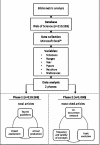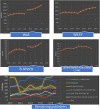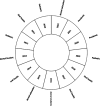Factors associated with scientific production citations in dentistry: Zero-inflated negative binomial regression and hurdle modelling
- PMID: 38973941
- PMCID: PMC11226947
- DOI: 10.12688/f1000research.141422.1
Factors associated with scientific production citations in dentistry: Zero-inflated negative binomial regression and hurdle modelling
Abstract
Background: The global scientific literature in dentistry has shown important advances in the field, with major contributions ranging from the analysis of the basic epidemiological aspects of prevention to specialised results in the field of dental treatments. The present investigation aimed to analyse the current state of the scientific literature on dentistry hosted in the Web of Science database. Methods: The methodology included two phases in the analysis of articles and indexed reviews in all thematic areas. During the first phase, the following variables were analysed: scientific production by the publisher, the evolution of scientific output published by publishers, the factors associated with the impact of scientific production, and the modelling of the impact of scientific production on dentistry. During the second phase, associations, evolutions, and trends in the use of keywords in the scientific literature in dentistry were analysed. Results: The first phase shows that scientific production in dentistry will increase between 2010 and 2021, reaching 12,126 articles in 2021. Publishers such as Wiley and Elsevier stand out, but Quintessence Publishing has the most citations. Factors such as pages, authors, and references influence the number of citations. Phase 2 analyzes trends in the dental literature using the WoS database. Topics such as "dental education", "pediatric dentistry", and "pandemic" stand out. The intersection of technology and dentistry and the importance of evidence-based education are highlighted. Conclusions: In conclusion, the study shows that the most studied topics include the association of dental education and the curriculum, the association of pediatric dentistry with oral health, and dental care. The findings show that more recently emphasised topics also stand out, such as evidence-based dentistry, the COVID-19 pandemic, infection control, and endodontics, as well as the need for future research to expand current knowledge based on emerging topics in the scientific literature on dentistry.
Keywords: Dentistry; Information / Knowledge Management; Research methods; bibliometric; dentistry; infection control; pandemic; scientific production.
Copyright: © 2023 Millones-Gómez PA et al.
Conflict of interest statement
No competing interests were disclosed.
Figures





Similar articles
-
Bibliometrics to improve our patients' care!Eur J Paediatr Dent. 2022 Sep;23(3):173. doi: 10.23804/ejpd.2022.23.03.01. Eur J Paediatr Dent. 2022. PMID: 36172914
-
A Scientometric Analysis of Scholarly Output on COVID-19 and Dentistry.Int Dent J. 2022 Oct;72(5):725-730. doi: 10.1016/j.identj.2022.04.007. Epub 2022 Apr 14. Int Dent J. 2022. PMID: 35595556 Free PMC article.
-
RANDOMIZED CONTROLLED TRIALS IN DENTAL JOURNALS ON CHILDREN AND ADOLESCENTS: A BIBLIOMETRIC ANALYSIS.J Evid Based Dent Pract. 2021 Dec;21(4):101621. doi: 10.1016/j.jebdp.2021.101621. Epub 2021 Aug 10. J Evid Based Dent Pract. 2021. PMID: 34922725
-
Impact of COVID-19 Dentistry-Related Literature: An Altmetric Study.Int Dent J. 2023 Oct;73(5):770-776. doi: 10.1016/j.identj.2022.11.005. Epub 2022 Nov 17. Int Dent J. 2023. PMID: 36641342 Free PMC article. Review.
-
[Breast pathology: evaluation of the Portuguese scientific activity based on bibliometric indicators].Acta Med Port. 2006 May-Jun;19(3):225-34. Epub 2006 Sep 7. Acta Med Port. 2006. PMID: 17234084 Review. Portuguese.
References
-
- Garcés-Giraldo LF, et al. : Tendencias en el uso del marketing digital en el sector turismo: una perspectiva bibliométrica. Revista Ibérica de Sistemas e Tecnologias de Informação. 2022;E50:631–643.
-
- Godín B: Sobre los orígenes de la bibliometría. Cienciometría. 2006;68:109–133.
-
- Anchundia KAP, Rivera MTS: La revista ECA Sinergia, rasgos distintivos y contexto histórico: Aplicación de análisis métrico a su producción científica. ECA Sinerg. 2021;12:86–96. 10.33936/eca_sinergia.v12i3.3534 - DOI
MeSH terms
LinkOut - more resources
Full Text Sources

